Code Green Solutions


It’s been 5 months since we announced the launch of GRESB Infrastructure. Now, we’ve reached a major milestone: the pre-release of the 2016 GRESB Infrastructure Assessment. This marks an important step forward in our effort to create a new global benchmark for the environmental, social, and governance (ESG) performance of infrastructure investments. Let’s mark this milestone by reflecting on two observations from the last five months of development:
1. Infrastructure ESG performance must balance beneficial output with social and environmental impacts.
Infrastructure is different from other asset classes. Infrastructure investments typically focus on a core activity that has a desirable social benefit, such as generating energy, moving people, cleaning water, or a myriad of other services. Generally speaking, we want to maximize these beneficial outputs, and we don’t want ESG assessments that suggest that less output is de facto better for people and the environment. However, we also recognize that these beneficial outputs come with significant environmental and social externalities, such as greenhouse gas emissions, waste, injuries, community impacts, and more. Consequently, the challenge is to understand how a given infrastructure investment is acting to maximize beneficial outputs while minimizing social and environmental externalities. The new GRESB Infrastructure Assessment will help investors understand whether their investments (or potential investments) are leading or lagging behind their peers in creating beneficial outputs while minimizing negative externalities.
2. Infrastructure ESG communications vary widely in their scope, quality, and level of detail.
The second observation is that infrastructure companies and funds often communicate about their ESG policies and performance. This isn’t new or novel. However, it is equally clear that communications come in a wide range of forms and formats. The result is that it is challenging for investors to get comparable information about investments around the world. Moreover, even when the same information is provided, it is difficult to objectively score data and create meaningful quantitative comparisons. At best, the quality of such efforts is entirely dependent on the expertise and resources available to individual investors. Asset operators and fund managers are similarly in the dark, facing a sea of heterogeneous information, little of which can be directly applied to understand the strengths and weaknesses of any given entity. The new GRESB Infrastructure Assessment can help fill this gap and topple this Tower of Babel. GRESB Infrastructure will provide institutional investors with a systematic tool to request ESG data from a wide-variety of investment types and provide a core set of comparative analytics to inform decision-making.
We are looking forward to learning more as we engage with investors and investments to help them try out the new GRESB Infrastructure Assessment starting on April 1. The Assessment will be available in pre-release on March 7 via the GRESB website. Visit GRESB.com to learn more.